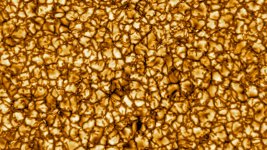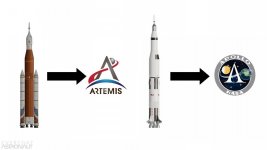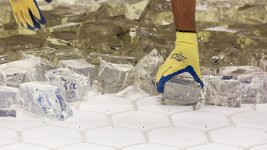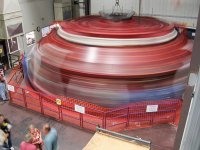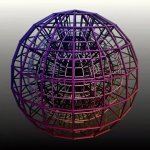The octagonal spiky flares are not from the supports struts but from the mirror shapes. So this one will have some too.
Yes, they run a laser in the direction of the telescope and measure the error in its image in order to be used for correction of atmosphere distorsion.
//
Yes, they run a laser in the direction of the telescope and measure the error in its image in order to be used for correction of atmosphere distorsion.
//
I think the mirror is probably one of those ones where the mirror is stressed in segments using electronics to remove minute flaws. The telescope housing is 12 stories high 👍
Adaptive optics was the term I was looking for. The ESO ELT has a light gathering surface area of 978 m^2. That’s c. 30m x 30m 😳
https://en.m.wikipedia.org/wiki/Extremely_Large_Telescope
https://en.m.wikipedia.org/wiki/Extremely_Large_Telescope
I didn't know there are so many huge telescopes in operation or planned.
Adaptive optics, laser beam steering and atmospheric correction, infra-red, ultra-violet... it's really all quite baffling! 😕
https://en.m.wikipedia.org/wiki/Gran_Telescopio_Canarias
https://en.wikipedia.org/wiki/Thirty_Meter_Telescope
https://en.wikipedia.org/wiki/Very_Large_Telescope
https://en.m.wikipedia.org/wiki/Extremely_Large_Telescope
But I checked on JWST. The 8 pointed pattern is a combination of the 3 asymmetric support struts and AFAIK, the hexagonal outside shape of the mirror. They could have got hexagonal spikes with a different equilateral strut design.
https://www.theverge.com/23220109/james-webb-space-telescope-stars-diffraction-spike

It appears the Giant Magellan will have circular fraunhofer diffraction rings familiar to users of refractors:

I find the "200 times more powerful" statement questionable. This image surprises me too, because I would have expected a hexagonal diffraction spike pattern. Must be missing something.

Interesting mathematical diffraction problem! I always found aperture diffraction interesting. Something is cancelling out here! Will sleep on it! 🙂
Adaptive optics, laser beam steering and atmospheric correction, infra-red, ultra-violet... it's really all quite baffling! 😕
https://en.m.wikipedia.org/wiki/Gran_Telescopio_Canarias
https://en.wikipedia.org/wiki/Thirty_Meter_Telescope
https://en.wikipedia.org/wiki/Very_Large_Telescope
https://en.m.wikipedia.org/wiki/Extremely_Large_Telescope
But I checked on JWST. The 8 pointed pattern is a combination of the 3 asymmetric support struts and AFAIK, the hexagonal outside shape of the mirror. They could have got hexagonal spikes with a different equilateral strut design.
https://www.theverge.com/23220109/james-webb-space-telescope-stars-diffraction-spike
It appears the Giant Magellan will have circular fraunhofer diffraction rings familiar to users of refractors:
I find the "200 times more powerful" statement questionable. This image surprises me too, because I would have expected a hexagonal diffraction spike pattern. Must be missing something.
Interesting mathematical diffraction problem! I always found aperture diffraction interesting. Something is cancelling out here! Will sleep on it! 🙂
Last edited:
The Verge:
"Both the primary and secondary mirrors contribute to the diffraction spikes but in slightly different ways. Light diffracts, or bends, around objects like mirror edges. So the shape of the mirror itself can result in these spikes of light as light interacts with the edges of the mirror. In Hubble’s case, the mirror was round, so it didn’t add to the spikiness. But JWST has hexagonal mirrors that result in an image with six diffraction spikes."
Did you even read your linked page? :-D
//
"Both the primary and secondary mirrors contribute to the diffraction spikes but in slightly different ways. Light diffracts, or bends, around objects like mirror edges. So the shape of the mirror itself can result in these spikes of light as light interacts with the edges of the mirror. In Hubble’s case, the mirror was round, so it didn’t add to the spikiness. But JWST has hexagonal mirrors that result in an image with six diffraction spikes."
Did you even read your linked page? :-D
//
The thermal cells on the Sun's surface are hexagonal (bit like the one on the poles of Saturn - or is that Pentagonal in shape?). I saw a paper from someone a few years back that described why this was the case - cant find it now.
So, it does seem there is something with these hexagonal/pentagonal shapes. Must be 'aliens'.
BTW I am a certified alien. Every time I went to the USA, I had to fill in an 'Alien Landing Card'. My brother is a long term resident and US citizen, so he and his family have been 'de-Alienated' 🙂
So, it does seem there is something with these hexagonal/pentagonal shapes. Must be 'aliens'.
BTW I am a certified alien. Every time I went to the USA, I had to fill in an 'Alien Landing Card'. My brother is a long term resident and US citizen, so he and his family have been 'de-Alienated' 🙂
The thermal cells on the Sun's surface are hexagonal...
The attached photo was taken by the Daniel K. Inouye Solar Telescope a few years back.
The cell-like structures are each about the size of Texas.
I can see all manner of shapes in the image. 😎
Attachments
Destination Moon! 
The Space Launch System (SLS) rocket is on the launchpad and poised to send an Orion spaceship on its first mission - a flight around the moon.
In Greek mythology, Artemis was the twin sister of Apollo and goddess of the moon.
Get acquainted with her here: https://www.dailymail.co.uk/science...-compares-Neil-Armstrongs-launch-vehicle.html

The Space Launch System (SLS) rocket is on the launchpad and poised to send an Orion spaceship on its first mission - a flight around the moon.
In Greek mythology, Artemis was the twin sister of Apollo and goddess of the moon.
Get acquainted with her here: https://www.dailymail.co.uk/science...-compares-Neil-Armstrongs-launch-vehicle.html
Attachments
TBH, I don't find Artemis a tremendously exciting project. There is little reason to fly to the moon IMO, except to set up a Space Telescope in one of the polar craters. Otherwise it is just dead and dull rocks.
I am unsure if Artemis is Environmentally friendly, either? Surely Elon Musk's Heavy Falcon rocket is far more recyclable too.
In fact a lot of the Space Probes are starting to look like a waste of time! JWST, I am looking at YOU! 🙁
Anywhoo, back on-topic. This 24m Giant Magellan Telescope is superb. Height of 22 stories in enclosure, adaptive optics (correcting every thousandth of a second for atmospheric turbulence on the secondary mirror) to deal with a blurry atmosphere, and very few spikes due to clever design.
Have gathered a few images together to explain most of the subtleties. It is essentially a three element Gregorian reflector. Which corrects most of the aberrations. 🙂


Herte's an assymetric solution which has been proposed.

Back to GMT:

Another proposal:

Back to the GMT sensors:

The struts lie between the mirrors, hence don't interfere with spikes except on the central mirror. I am unsure how the circular mirrors help here, but it is interesting that the secondary mirror matches the primary in 7 elements. Hope that clears it up.
I am unsure if Artemis is Environmentally friendly, either? Surely Elon Musk's Heavy Falcon rocket is far more recyclable too.
In fact a lot of the Space Probes are starting to look like a waste of time! JWST, I am looking at YOU! 🙁
Anywhoo, back on-topic. This 24m Giant Magellan Telescope is superb. Height of 22 stories in enclosure, adaptive optics (correcting every thousandth of a second for atmospheric turbulence on the secondary mirror) to deal with a blurry atmosphere, and very few spikes due to clever design.
Have gathered a few images together to explain most of the subtleties. It is essentially a three element Gregorian reflector. Which corrects most of the aberrations. 🙂
Herte's an assymetric solution which has been proposed.
Back to GMT:
Another proposal:
Back to the GMT sensors:
The struts lie between the mirrors, hence don't interfere with spikes except on the central mirror. I am unsure how the circular mirrors help here, but it is interesting that the secondary mirror matches the primary in 7 elements. Hope that clears it up.
Last edited:
Wow, I didn't expect to find SOTA astronomy discussions here. "Crackpot" hat on:
1D universe is a thin ring. 2D universe is a hollow ball. 3D universe is... we don't have a common name for it. Fire a photon in any direction in empty space so as to ignore gravitational curvature, it will eventually circumnavigate along the shortest path (great circle on a ball) back to the point of origin, unless stopped, or the universe expands faster than c. The universe is "closed" in the sense that it is finite and a straight line geometrically loops back. The universe may be "open" (or not) in the sense that it expands inside a higher dimension, for example 1D ring expands over a 2D sheet, 2D hollow ball expands inside 3D space, etc.
If the universe does not expand, then red shift is the ageing of light as it loses energy pushing against "ether" resistance at terminal velocity c for a very long time. Gravity also propagates at the same maximum "refresh rate" built into the firmament of space-time.
Crackpot hat off.
1D universe is a thin ring. 2D universe is a hollow ball. 3D universe is... we don't have a common name for it. Fire a photon in any direction in empty space so as to ignore gravitational curvature, it will eventually circumnavigate along the shortest path (great circle on a ball) back to the point of origin, unless stopped, or the universe expands faster than c. The universe is "closed" in the sense that it is finite and a straight line geometrically loops back. The universe may be "open" (or not) in the sense that it expands inside a higher dimension, for example 1D ring expands over a 2D sheet, 2D hollow ball expands inside 3D space, etc.
If the universe does not expand, then red shift is the ageing of light as it loses energy pushing against "ether" resistance at terminal velocity c for a very long time. Gravity also propagates at the same maximum "refresh rate" built into the firmament of space-time.
Crackpot hat off.
Last edited:
"Crackpot" hat on:
Welcome wchang! I hope you are not suggesting we are all "crackpots" here!




1D universe is a thin ring. 2D universe is a hollow ball. 3D universe is... we don't have a common name for it.
I am familiar with the fact that, in geometry, the dimensions progress as follows.
1D: line segment
2D: circle
3D: sphere
4D: glome
There is a hypothesis that the early universe was a one dimensional line. https://www.livescience.com/33228-early-universe-1-d-line-vanishing-dimensions-theory.html#:~:text=It proposes that the early universe was a,at large distances, appeared as a 2-D plane.
"Over time, as that line grew, it crisscrossed and intersected itself more and more, gradually forming a tightly interwoven fabric, which, at large distances, appeared as a 2-D plane. More time passed and the 2-D universe expanded and twisted about, eventually creating a web - the 3-D universe we see today."
This is called the "vanishing dimensions" hypothesis, as it proposes that the early universe contained fewer spatial dimensions than the three we see today.
Hope that clears it up.
I get the big picture - or should I say pictures? 😉
but having the folks walking on it with a mop seems a bit... disrespectful. (reminds me of Joseph Beuys' little scandal, where some service-peolple asked "Ist das Kunst oder kann das weg?")There will be seven mirror segments, and the size of the central segment alone can be appreciated by looking at the attachment.
I am confident though that these folks at (on) the scope know what they're standing on
but having the folks walking on it (the central mirror segment) with a mop seems a bit... disrespectful.
Don't worry, the mirror segment will undergo two years of meticulous surface polishing to achieve a final optical surface precision of 25 nanometres!
https://giantmagellan.org/telescope-primary-mirrors/
EDIT: We see in the picture I posted the shapes of the honeycomb mold for the mirror glass, which is used to achieve a lightweight structure.
https://spie.org/news/photonics-focus/mayjun-2020/casting-giant-telescope-mirrors?SSO=1
Last edited:
Attached is the low expansion glass being placed in the honeycomb mold.
The mirror is spun into a parabolic shape as the glass cools, which takes three months!"They decided that it would be easier to build a mold with the inverse honeycomb structure inside, add the glass in broken chunks, and then melt it all in a furnace. The ceramic fiber used to make the honeycomb could be power washed out of the mirror once everything cooled, leaving the mirror 80 percent hollow."
Attachments
Last edited:
I think a "Glome" must be a 3-sphere surface embedded in a 4D spacetime manifold... but it's a new word to me! 😕
Happy hours spent at Atlas Obscura yesterday. The thinking persons website. Endless interest there. I even learned new uses for baking soda and how to make fruit curries...
https://www.atlasobscura.com/articles/podcast-star-trek-original-series-set-tour
An entertaining podcast about the Star Trek set recreation in New York, which is quite the Mecca for Trekkies:
https://www.startrektour.com/photo-gallery/our-beautifully-recreated-set/

The sick bay exhibits primitive instruments which must date from the Battle of Trafalgar in 1805! 😛

Of course, Bones used more advanced scanners and fixers than that...

In fact these odd things are based on Swedish Salt and Pepper shakers. The ones with the dark red and green bottoms are the originals. The rest were knocked up by the props department on a lathe. Interestingly they were also used by Mr. Scott and Spock to fix broken computers. Technology beyond our understanding. 😀
Happy hours spent at Atlas Obscura yesterday. The thinking persons website. Endless interest there. I even learned new uses for baking soda and how to make fruit curries...
https://www.atlasobscura.com/articles/podcast-star-trek-original-series-set-tour
An entertaining podcast about the Star Trek set recreation in New York, which is quite the Mecca for Trekkies:
https://www.startrektour.com/photo-gallery/our-beautifully-recreated-set/
The sick bay exhibits primitive instruments which must date from the Battle of Trafalgar in 1805! 😛
Of course, Bones used more advanced scanners and fixers than that...
In fact these odd things are based on Swedish Salt and Pepper shakers. The ones with the dark red and green bottoms are the originals. The rest were knocked up by the props department on a lathe. Interestingly they were also used by Mr. Scott and Spock to fix broken computers. Technology beyond our understanding. 😀
I think a "Glome" must be a 3-sphere surface embedded in a 4D spacetime manifold... but it's a new word to me! 😕
I mentioned the glome earlier in the thread.
The glome is the 4D representation of the 3D sphere and 2D circle.
The name derives from the Latin "glomus" meaning "ball of string".
In fact these odd things are based on Swedish Salt and Pepper shakers.
Interestingly, conical shapes frequently pop up in 60s/70s sci-fi series - take U.F.O. for example.
Attachments
I want one! Would be nice if Bezos, Musk and co would fund projects like this.TBH, I don't find Artemis a tremendously exciting project. There is little reason to fly to the moon IMO, except to set up a Space Telescope in one of the polar craters. Otherwise it is just dead and dull rocks.
I am unsure if Artemis is Environmentally friendly, either? Surely Elon Musk's Heavy Falcon rocket is far more recyclable too.
In fact a lot of the Space Probes are starting to look like a waste of time! JWST, I am looking at YOU! 🙁
Anywhoo, back on-topic. This 24m Giant Magellan Telescope is superb. Height of 22 stories in enclosure, adaptive optics (correcting every thousandth of a second for atmospheric turbulence on the secondary mirror) to deal with a blurry atmosphere, and very few spikes due to clever design.
Have gathered a few images together to explain most of the subtleties. It is essentially a three element Gregorian reflector. Which corrects most of the aberrations. 🙂
View attachment 1082524
View attachment 1082525
Herte's an assymetric solution which has been proposed.
View attachment 1082526
Back to GMT:
View attachment 1082527
Another proposal:
View attachment 1082528
Back to the GMT sensors:
View attachment 1082529
The struts lie between the mirrors, hence don't interfere with spikes except on the central mirror. I am unsure how the circular mirrors help here, but it is interesting that the secondary mirror matches the primary in 7 elements. Hope that clears it up.
- Status
- Not open for further replies.
- Home
- Member Areas
- The Lounge
- What is the Universe expanding into..
